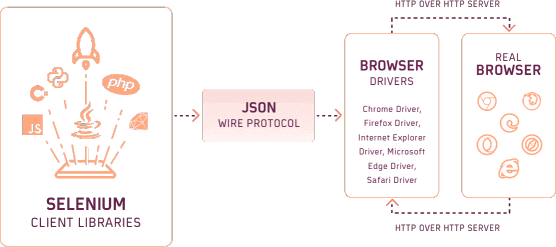Selenium is the most popular open-source automated testing framework. It allows users to automatically test websites or web applications across various browsers and operating systems. It allows quality assurance specialists to automate their web tests using any programming language they are most familiar with. It is compatible with many computer languages, including C#, Java, Python, JavaScript, and many more. In this article, we will read about the best practices while working with Selenium WebDriver.
Quality assurance experts may deliver test cycles faster by using Selenium to automate repetitive test cases. When connected with a CD/CI pipeline, it may also assist in developing an error-free and reliable delivery pipeline. The Selenium Grid, the Selenium Web Driver, the Selenium IDE, and the Selenium Remote Control are just a few of the technologies it integrates. It helps in greatly simplifying both regression testing and automating online interactions. The user can find that performing regression testing is a lot simpler.
You also have access to playback and recording, a useful option. The toolkit enables you to export scripts and reuse them as you advance. While this happens, you continue to fully control how the process is set up and what information you must include.
Table of Contents
Selenium Automation Platform
Selenium, an automated testing framework, is widely used in web development. Almost all businesses that conduct business online, whether through a website or a web application, are integrating the Selenium testing tool into their testing processes. Although Selenium is a framework for automated tests, it is not just for testers. Selenium provides software engineers with a choice of open avenues through which they can automate their unit test activities because it is compatible with many programming languages. DevOps teams use Selenium as part of their technologies for Continuous Development and Integration. This guarantees that a total round of automated browser testing is carried out each time a code is changed from one staging environment to another.
Selenium supports many independent web testers and developers as it is a free framework. To put it another way, user interface developers can use Selenium to perform visual regression testing once the integration process is over. Even independent web developers may perform debugging and testing via the Selenium platform. Using Selenium, quality assurance testers can write specialized deterministic tests and scripts with enhanced coverage and accuracy.
What Are Some of the Different Types of Equipment That Selenium Depends On?
Selenium makes several tools for automating browser tasks available. It comprises three crucial Selenium parts, each with a special set of advantages for web testers.
● Selenium IDE(Integrated Development Environment)
● Selenium Grid
● WebDriver for Selenium
Selenium WebDriver History:
The Selenium WebDriver was created in 2007 by Simon Stewart, a ThoughtWorks Company-employee. This robust tool aimed to exert control over the web browser to get the desired outcome. Additionally, this automated test framework could run tests on several different platforms. The addition of WebDriver can fill up the loopholes left by Selenium. In fact, for a brief period, it was seen as a Selenium rival. The race between the two tools was put to rest in July 2011 when they combined to form Se 2.0, ending the rivalry. The WebDriver APIs were paired with Selenium, which now possesses original and upgraded traits.
Selenium WebDriver:
Selenium WebDriver is known to be one of the best collections of open-source application programming interfaces for automating the testing of web applications.
Selenium WebDriver is software used to test web applications to ensure they work as intended. It works with many browsers, including Safari, Firefox, Chrome, and Internet Explorer. On the other hand, using Selenium WebDriver is the only way we can automate testing for web apps. It doesn’t comply with the specifications for windows-based programs. It is also compatible with several programming languages, including C#, Perl, Java, PHP, and Ruby, to create test scripts. The Selenium WebDriver framework is platform-independent, as the same code can operate on several Operating Systems, such as Microsoft Windows and Linux. And Apple OS.
Managing window components is not possible with Selenium WebDriver. However, this restriction can be overcome using tools like Sikuli, the AUTO IT tool, etc. It employs several location strategies, including XPath, ID, Link text, Name, Class name, Partial link text, and CSS selector. It offers better support for dynamic web pages such as Ajax, which allows the web page elements to change without the page being reloaded. With the help of Jar files, the user can test databases, APIs, and other types of applications using Selenium WebDriver.
Selenium testing tools such as LambdaTest offer a cloud Grid that allows the user to run the parallel test for more than 30000 operating systems and browsers. The user just needs to install and use Selenium WebDriver rather than local Selenium WebDriver.

Here are some of the Best practices while working with the selenium web driver in 2023:
Using the Correct Locators:
Quality assurance specialists need to be skilled in several locator approaches to test the desired web components of a given application. After all, if the test scripts cannot accurately identify the elements being assessed, the tests will automatically fail.
For example, To automate the inputs for the login page, like username, password, etc., the first step will always be to locate the text fields. The authentication process will fail if the script cannot find the Username and Password fields.
Running Selenium-created tests on real devices:
The user can find many emulators available on the internet for testing via Selenium across the platform but running the test on real devices is a different experience.
Software applications that imitate the behavior of a hardware component are what emulators are all about. They work better when used to evaluate coding modifications in the early stages of the development process. It’s also likely that there are only emulators for some device-operating system combinations, which makes it even more challenging for quality assurance testers to test on the required configurations.
The only way to be certain of receiving reliable results is to test websites in real-world scenarios. This makes it possible for teams to find possible errors and deliver a trustworthy application.
Executing the Page Object Model:
Since customer needs are constantly expanding, a website’s user interface (UI) will progress following the deployment of new upgrades at regular intervals. Of course, the locators related to the various UI components will also change. It will be necessary for quality assurance specialists to create new test cases for the same page, which can be a time-consuming operation.
Testing test scripts utilizing the Page Object Model design pattern is one way to solve this problem. Every web page is handled like a class file in the context of this design pattern, and each class file contains the pertinent web elements. This tactic also makes it easier to maintain tests by avoiding code duplication. Additionally, QAs can reuse the current code by making a few minor changes to it.
Take screenshots when a test fails.
During the execution of a Selenium script, an error will inevitably occur. Finding the cause of the failure, whether it be a bug in AUT or a mistake in the code, is quite difficult in this case. Configure the testing infrastructure to take screenshots automatically each time an error happens to solve this issue. As a result, it is conducting an inquiry and figuring out why a test failure will be easier, saving the tester’s effort and time.
Replace Thread.sleep() with wait command
Individual online pages may take some time to load in a web browser. A website’s loading time might change depending on several variables, including the network environment, system requirements, and server issues. Quality assurance professionals typically employ the Thread. Sleep () method, which hibernates the automation script for a predetermined amount of time, to get around this problem.
There are more successful strategies than this strategy. A website’s loading time can go above the allocated time limit in certain situations. A website can load quicker than the allotted time, which would cause the test to run more slowly. The best and most efficient method with Selenium is to use either explicit or implicit Wait Commands.
Finding the test suits and cases and rating them:
There are times when it can be challenging to test complex web applications. It is significantly easier to achieve test coverage goals when some test cases are given more weight than others. The test cases that are the most crucial and ought to be run first must be clearly understood by the testing team.
For example, the login page is a crucial part of every web application. Automated tests to verify the reliability of the login page are a logical notion. This is because the login page undergoes relatively few changes even though it serves a crucial function. Testing it would be simple as a result, and the execution of the tests would guarantee that a crucial phase in the process was finished as soon as feasible.
Avoid hardcoding any test results:
Using test data that is hardcoded results in several issues. First, it makes your automated tests more brittle, increasing the likelihood of failing if the product under test is altered. This will also reduce the reusability of your tests. If you want to repeat the test using other data, you must quit the code and replace the hardcoded values. This takes a lot of time and increases the likelihood of making mistakes. Last but not least, hardcoding test data can slow down your tests. The time it takes for your tests to run indefinitely if data retrieval from a database or another external source is required during testing.
Always prefer early testing:
To make use of all the advantages that selenium testing has to offer, early and frequent testing is advised as one of the best practices. Starting with the requirement gathering stage, immediately put all of the Selenium Testing properties into practice.
Software testers and developers are better equipped to guarantee that the application will satisfactorily meet the end user’s needs. One benefit of using this approach is promptly communicating the test findings to the developers before the assignment is complete. It will save great money and time in the long term.
BDD Framework
One of the most popular development approaches for Selenium testing is behavior-driven development when considering the finest Selenium usage practices. The creation of automation scenarios is made straightforward for testers using this technique. Everyone can easily understand the test cases because they were created by testers using the BDD framework; no coding knowledge is necessary.
Task Separation
Another crucial process that you must avail of with Selenium Testing is task assignment. Consider the various levels of knowledge the testing team members hold when you divide the test cases and test suites into their respective groups.
Selecting the Correct tool :
There are several different selenium testing tools available to ensure product quality. You must, however, be clear about which of these is most crucial to you. Before choosing the best selenium tool, it’s crucial to consider the requirements of the users as well as the tool’s compatibility with the software.
Test Recognition
Before testing, remember to specify your objectives and decide which test to automate first. Before attempting other scenarios, always test those with the layout, fonts, and colors. You will eventually be allowed to move on to other test cases after that, but you will have to do so in a synchronized order.
Never automate tests related to unstable elements:
The company’s owners reserve the right to decide to change some parts of the program in the future. It may be necessary to test unstable elements more than once if they are more prone to alter over time. As a result, it is advised against automating the test for unstable components.
Selenium automation helps in reducing manual efforts in testing, identify possible bugs, and enhance execution speed. To get the best out of the Selenium scripts, the tester can follow the listed Selenium WebDriver best practices. While using the various test scenarios for Selenium the user should know that Selenium is best for automated testing so using it will help you in saving time, and effort and generate favorable results.

Alex is fascinated with “understanding” people. It’s actually what drives everything he does. He believes in a thoughtful exploration of how you shape your thoughts, experience of the world.


